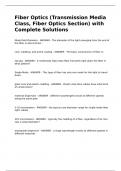Samenvatting
Summary Commensal and Pathogen Host-Microbe Interactions in the Intestine (HMI-50806)
- Instelling
- Wageningen University (WUR)
Summary of the lectures of the course "Commensal and Pathogen Host-Microbe Interactions in the Intestine" (HMI-50806).
[Meer zien]













